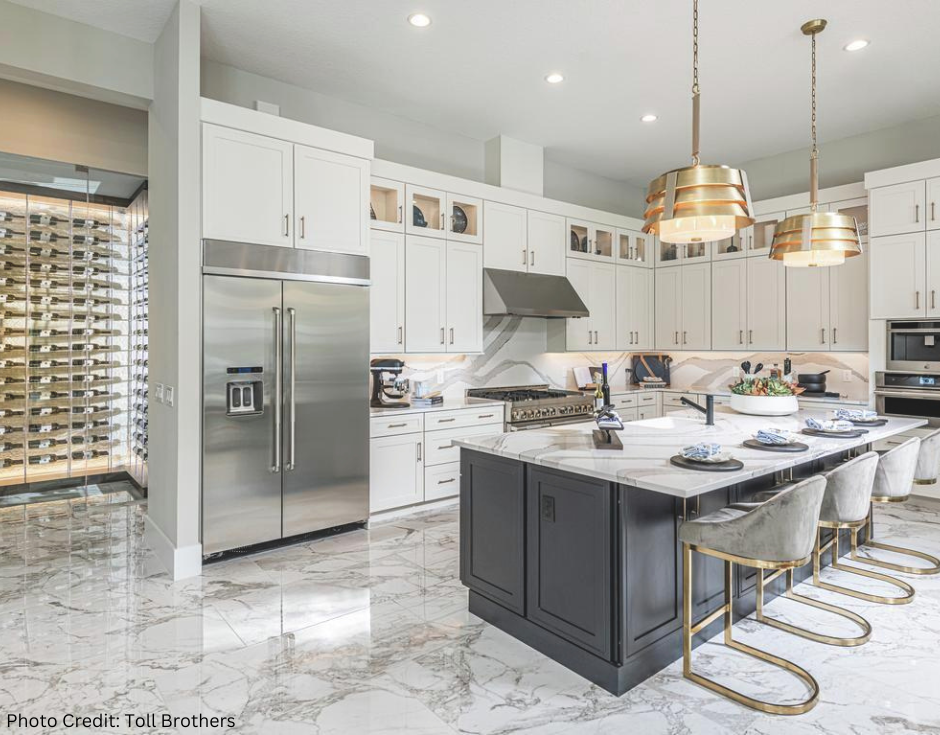Designing a well-coordinated kitchen involves careful consideration of colors. Each element plays a vital role in creating a cohesive and visually pleasing space, from cabinets to countertops, backsplash, and floors. We’ve got you covered if you want to bring harmony to your kitchen’s color scheme. This guide will provide expert tips and insights on effectively coordinating kitchen colors. Read on how to coordinate kitchen colors: cabinets, countertops, backsplash and floors.
How to Coordinate Kitchen Colors
Understand the Color Wheel and How to Use It
To begin your journey towards a harmonious kitchen color scheme, it’s important to understand the color wheel and its principles. The color wheel consists of primary, secondary, and tertiary colors, which can guide your decision-making process. Our paint specialists can help you select the best paint for your kitchen cabinets.
Choose a Primary Color for Your Cabinets
The cabinets are the kitchen’s focal point, so selecting the right color is crucial. Consider the overall style and atmosphere you want to create. Start by selecting a primary color for your cabinets. Consider the overall style and atmosphere you want to create in your kitchen. Neutral shades like white, gray, or beige cabinets offer versatility and timelessness, while bold hues such as navy blue or deep green can make a dramatic statement. Ensure the cabinet color sets the foundation for the rest of the color scheme. Browse our favorite shades of grey from Benjamin Moore Paints.
Select Countertop Materials and Colors
Regarding countertops, there’s a wide range of materials and colors. Consider the existing color palette of your kitchen and select a countertop that complements or contrasts with your cabinet color. Neutral countertops like granite or quartz can work well with any color scheme, while bold countertops like butcher block or colorful quartz can add character to your kitchen.
Consider Your Backsplash Options
The backsplash offers an opportunity to introduce a pop of color or texture to your kitchen. Look for materials that tie in with the overall color scheme. Subway tiles in neutral tones or vibrant mosaic tiles can add visual interest. Consider the height of the backsplash and how it interacts with the cabinets and countertops for a seamless look. Ensure the backsplash harmonizes with the other elements without overpowering the overall color scheme.
Use Floor Tiles to Tie Everything Together
The floor is a crucial element that can help unify the different components of your kitchen. Consider the material, color, and pattern of the flooring. Opt for a neutral floor to create balance if you have a busy backsplash or vibrant cabinets. Conversely, if your cabinets and countertops are neutral, consider a patterned or textured floor tile to add visual appeal.
Add Finishing Touches with Accessories & Greenery
Once you have coordinated the main elements of your kitchen, it’s time to add the finishing touches. Accessories such as curtains, rugs, and kitchen utensils can enhance the color scheme. Introducing plants or fresh herbs can bring life and a splash of natural green to your kitchen.
Coordinating kitchen colors requires thoughtful planning and consideration of various elements. Understanding the color wheel and following the tips outlined in this guide can create a harmonious and visually stunning kitchen. Remember to choose a primary color for your cabinets, select complementary countertops and backsplash options, use floor tiles to tie everything together, and add the perfect finishing touches with accessories and greenery. With these expert tips from Wallauer Paint and Design, you’ll be well on your way to designing a functional and aesthetically pleasing kitchen.

 Interior Paints
Interior Paints Exterior Paints
Exterior Paints Primers
Primers Stains & Clears
Stains & Clears
 Paint Brushes
Paint Brushes Paint Roller
Paint Roller Paint Trays & Liners
Paint Trays & Liners
